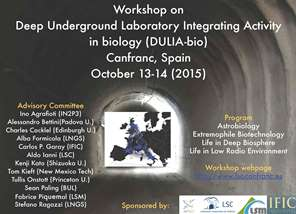Description
F.Fischietti1,2, A.Tessitore2, P.Sykes3, G.Cenci4; M.Balata5, M.Chiti6, A.Esposito6, G.Esposito7,8, M.Belli7, M.A.Tabocchini1,7, L.Satta1
on behalf of the Cosmic Silence collaboration
1Museo Storico della Fisica e Centro Studi e Ricerche Enrico Fermi, Roma, Italy; 2L’Aquila University, Italy; 3Flinders University, Adelaide, Australia; 4La Sapienza University, Rome, Italy; 5INFN-LNGS; 6INFN-LNF; 7 Istituto Superiore di Sanità and INFN Roma1-Gr.coll.Sanità, Roma, Italy.
In 1995, Satta and co-workers, taking advantage of the opportunity given by the presence of the underground Gran Sasso National Laboratory (LNGS) of the Italian National Institute of Nuclear Physics (INFN), carried out experiments aimed at investigating the possible modulation of the mutagenic potential of chemical agents in yeasts kept for 120 generations in extremely low radiation environment (LRE). This work showed that low radiation background impairs biological defence of the yeast Saccharomyces cerevisiae to chemical radiomimetic agents. Since then, in the framework of a wider collaboration, the biological underground research activity at LNGS continued. The so called Pulex experiments (with reference to the MACRO experiment, running in those years underground LNGS) further investigated the influence of the radiation environment on the metabolism and the stress response mechanisms of cultured rodent and human cells maintained in parallel, for an equal number of generations as yeasts, in conditions of different environmental radiation. The overall data have shown that, similarly to yeasts, mammalian cells maintained underground LNGS develop a different biochemical behaviour, compared to those maintained in reference radiation environment (RRE). In particular, cells cultured in the LNGS underground laboratory were less preserved from DNA damage induced by chemical and physical agents, and showed a reduced Reactive Oxygen Species (ROS) scavenging power than cells cultured in the external laboratory, e.g. set up at the Istituto Superiore di Sanità, Rome.
More recently, the Cosmic Silence Project started with the aim to deepen the investigation of the molecular mechanisms involved in the environmental radiation response of biological systems by using sensitive in vitro (A11 hybridoma cells derived from transgenic pKZ1 mouse model) and in vivo models (Drosophila melanogaster and pKZ1 transgenic mice), showing different levels of complexity in the phylogenetic tree.
Data on A11 cells, kindly donated by Prof. Pamela Sykes, Flinders University, Adelaide, Australia, obtained after 1 months of culture in LRE and RRE corroborate the hypothesis that environmental radiation contributes to the development and maintenance of defence mechanisms. Furthermore, the results obtained also show that modulation of the gamma component intensity of the underground environmental radiation does not significantly influence the biological response. Characterization of the radiation field by measurements and simulations, with special emphasis to the neutron component, is in progress in the LRE and RRE laboratories.
Presently, besides the cell culture laboratory, a new facility for housing living organisms is under construction underground at LNGS. Once it will be ready, the first step will be to start experiments using Drosophila melanogaster. Drosophila melanogaster is indeed a well-established model for genetic analyses on development, aging as well as DNA damage response. This organism shows several advantages in laboratory practice, due to its relatively short reproduction time (ten-days generation time), high fertility with many progeny. Finally, a large number of developmental processes are conserved between fruit fly and vertebrates, thus making Drosophila a great candidate as complementary organism for the Cosmic Silence experiment. Eventually, once the license from the competent Authorities will be obtained, experiment will be carried out using the pKZ1 mouse model that represents the gold standard in this field.
